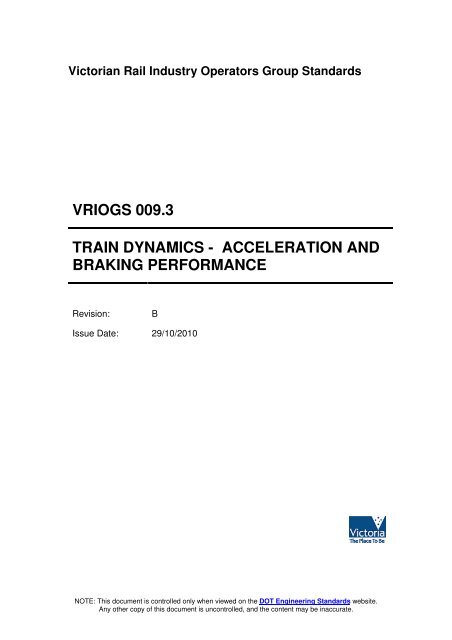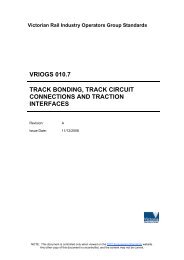VRIOGS 009.3 - Train Dynamics - Public Transport Victoria
VRIOGS 009.3 - Train Dynamics - Public Transport Victoria
VRIOGS 009.3 - Train Dynamics - Public Transport Victoria
You also want an ePaper? Increase the reach of your titles
YUMPU automatically turns print PDFs into web optimized ePapers that Google loves.
<strong>Victoria</strong>n Rail Industry Operators Group Standards<strong>VRIOGS</strong> <strong>009.3</strong>TRAIN DYNAMICS - ACCELERATION ANDBRAKING PERFORMANCERevision:BIssue Date: 29/10/2010NOTE: This document is controlled only when viewed on the DOT Engineering Standards website.Any other copy of this document is uncontrolled, and the content may be inaccurate.
ii<strong>VRIOGS</strong> <strong>009.3</strong> Revision B<strong>VRIOGS</strong> <strong>009.3</strong> TRAIN DYNAMICS - ACCELERATION AND BRAKINGPERFORMANCERevision BIssue Date: 29/10/2010APPROVAL STATUSAPPROVER STATUS DATE QUALIFICATIONSDocument DeveloperVRIOG SteeringCommitteeApprovedAll SectionsAccredited Rail OperatorMetropolitan <strong>Train</strong>(Metro <strong>Train</strong>sMelbourne)Intrastate <strong>Train</strong>(V/Line)Interstate <strong>Train</strong>(ARTC)Tram(Yarra Trams)For any queries please contact vriogs@transport.vic.gov.au.NOTE: This document is controlled only when viewed on the DOT Engineering Standards website.Any other copy of this document is uncontrolled, and the content may be inaccurate.
<strong>VRIOGS</strong> <strong>009.3</strong> Revision BiiiPURPOSE OF THE STANDARDThe Standard has been created through the collaboration of members of the<strong>Victoria</strong>n Rail Industry Operators’ Group (VRIOG) for the purpose of establishingstandards which, if implemented throughout the <strong>Victoria</strong>n Rail Network, will facilitatethe interoperability of infrastructure.The use of the Standard is not prescribed by law but, if adopted, conformity with theprovisions of the Standard is mandatory in order that the purpose of the Standard beachieved.DISCLAIMERThe Standard is published by the Director of <strong>Public</strong> <strong>Transport</strong> for informationpurposes only and does not amount to any kind of advice.Each person is responsible for making his or her own assessment of all suchinformation and for verifying such information. The content of this publication is not asubstitute for professional advice.The Director of <strong>Public</strong> <strong>Transport</strong> and VRIOG accept no liability for any loss ordamage to any person, howsoever caused, for information contained in thispublication, or any purported reliance thereon.COPYRIGHT STATEMENT© Director of <strong>Public</strong> <strong>Transport</strong> 2005.This publication is copyright. No part may be reproduced by any process except inaccordance with the provisions of the Copyright Act.Where information or material is so used, it should be used accurately and theStandard should be acknowledged as the source of the information.NOTE: This document is controlled only when viewed on the DOT Engineering Standards website.Any other copy of this document is uncontrolled, and the content may be inaccurate.
iv<strong>VRIOGS</strong> <strong>009.3</strong> Revision BSECTION 1.0CONVENTIONS1) Words or phrases that appear capitalised out of context are defined within theDefinitions section of this VRIOG Standard.2) The word “Shall” is to be understood as mandatory.3) The word “Should” is to be understood as non-mandatory i.e. advisory orrecommended.4) Uncontrolled Standards may not be referenced within the VRIOG Standards.These include former PTC Standards, Franchisee Standards, FranchiseeSubcontractor Standards and Infrastructure Lessee Standards.5) Controlled Standards, including Australian Standards and other <strong>VRIOGS</strong>tandards, may be referenced but only if:The referenced item can not be adequately explained with an amount oftext that could not reasonably be inserted into the body of the Standard.The reader is not referenced to another Controlled Standard necessaryfor the item to be adequately explained i.e. one document link only.The referenced document is a Figure or table and could not reasonablybe included in the appendices of the Standard.6) The format employed in the VRIOG Standards is compatible with AustralianStandards, and will be used from this point on.7) The numbering system for the VRIOG Standards is chronologically sequentialfrom the point of introduction, and is not based on any form of interpretivesystem.8) The VRIOG Standards contain engineering information necessary to operatea safe Railway. VRIOG Standards will not contain any information that can beconstrued as a work instruction, procedure, process or protocol. Thisinformation forms the basis of each individual entity’s Safety AccreditationCertification, and, as such, is outside the scope of VRIOG Standards.NOTE: This document is controlled only when viewed on the DOT Engineering Standards website.Any other copy of this document is uncontrolled, and the content may be inaccurate.
<strong>VRIOGS</strong> <strong>009.3</strong> Revision BvSECTION 2.0DEFINITIONSTerminology used and / or applied in this Standard is defined as follows:TermAccredited RailOperator (ARO)EMUVRIOGDescriptionA Rail Infrastructure Manager or Rolling Stock Operator whois accredited under Part 5 of the Rail Safety Act 2006.Electric Multiple UnitThe <strong>Victoria</strong>n Rail Industry Operators’ Group comprising thefollowing members:• VicTrack• V/Line Passenger• Metro <strong>Train</strong>s Melbourne• Yarra Trams• Australian Rail Track Corporation (ARTC)• <strong>Public</strong> <strong>Transport</strong> Division of the Department of <strong>Transport</strong>(PTD)NOTE: This document is controlled only when viewed on the DOT Engineering Standards website.Any other copy of this document is uncontrolled, and the content may be inaccurate.
vi<strong>VRIOGS</strong> <strong>009.3</strong> Revision BSECTION 3.0SCOPE AND GENERAL3.1 ScopeThis document describes the acceleration and braking characteristics of the followingrolling stock:• VLocity• Sprinter• N Class• EMUAnd also the established ARTC train braking charts;• GW16• GW40The acceleration and braking characteristics data is an excel spreadsheet whichimbeds all the train dynamics information and presents this in the form of acalculator. Refer <strong>VRIOGS</strong> <strong>009.3</strong> RevA.xls.3.2 ApplicationThis document describes the acceleration and braking characteristics that may beuse for the design of a signalling system in the <strong>Victoria</strong>n Rail Network.It should be noted that this guideline will be a “living document”; in that it is intendedto capture all future rolling stock performance and dynamics, as the informationbecomes available to the Industry.3.3 BackgroundThis document captures all train dynamic data from the following sources:• <strong>Public</strong> <strong>Transport</strong> Corporation versions of train acceleration and braking<strong>Dynamics</strong>• Connex train acceleration and braking <strong>Dynamics</strong>• V/Line train acceleration and braking <strong>Dynamics</strong>• All ARTC braking chartsNOTE: This document is controlled only when viewed on the DOT Engineering Standards website.Any other copy of this document is uncontrolled, and the content may be inaccurate.
















